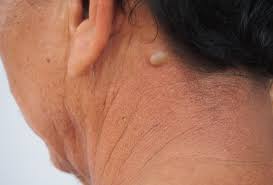
Sebaceous cysts are common noncancerous cysts of the skin. Cysts are abnormalities in the body that may contain liquid or semiliquid material.
Sebaceous cysts are mostly found on the face, neck, or torso. They grow slowly and aren’t life-threatening, but they may become uncomfortable if they go unchecked.
Doctors usually diagnose a cyst with only a physical examination and a medical history.
In some cases, a cyst will be examined more thoroughly for signs of cancer.
Sebaceous cysts form out of your sebaceous gland. The sebaceous gland produces the oil (called sebum) that coats your hair and skin.
Cysts can develop if the gland or its duct (the passage from which the oil is able to leave) becomes damaged or blocked. This usually occurs due to a trauma to the area.
The trauma may be a scratch, a surgical wound, or a skin condition, such as acne. Sebaceous cysts grow slowly, so the trauma may have occurred weeks or months before you notice the cyst.
Other causes of a sebaceous cyst may include:
- misshapen or deformed duct
- damage to the cells during a surgery
- genetic conditions, such as Gardner’s syndrome or basal cell nevus syndrome
Symptoms of a sebaceous cyst
Small cysts are typically not painful. Large cysts can range from uncomfortable to considerably painful. Large cysts on the face and neck may cause pressure and pain.
This type of cyst is typically filled with white flakes of keratin, which is also a key element that makes up your skin and nails. Most cysts are soft to the touch.
Areas on the body where cysts are usually found include:
scalp
face
neck
back
A sebaceous cyst is considered unusual — and possibly cancerous — if it has the following characteristics:
diameter that’s larger than five centimeters
fast rate of reoccurrence after being removed
signs of infection, such as redness, pain, or pus drainage
